- Visualizza Nuovi Contenuti
- Nikonland
- Sezioni
- Test
- Guide agli acquisti
- Indice Articoli
- Blog
- Forum
-
Fotografie
- Novità dalle Gallerie Fotografiche di Nikonland
- Una foto soltanto : Consigli & Critiche
- Ultime Immagini Caricate
- Ultimi Commenti
- _____________________________
- Contest e occasioni speciali di Nikonland
- Natura
- Fiori
- Ritratto
- Nudo
- Street
- Motori (auto e moto)
- Paesaggi e Panorami
- Architetture
- Viaggi e reportage di viaggio
- Sport (no motori)
- Vendo e Compro
- Downloads
-
Altro

Benvenuti su Nikonland Questo sito è indipendente, è autofinanziato, non promuove e non raccoglie pubblicità. Non è collegato con Nikon, Nital o le loro sussidiarie
Nikonland non è una rivista periodica e non è quindi sottoposta alla normativa vigente
Ultimi Test
-
 Panasonic Lumix DC- GH5: changing photography
Panasonic Lumix DC- GH5: changing photographyMax Aquila - gen 04 2018 17:26
-
 Sony Vario Sonnar 2,8/24-70 ZA SSM II: lo Zeiss...
Sony Vario Sonnar 2,8/24-70 ZA SSM II: lo Zeiss...Max Aquila - ago 08 2017 10:39
-
 Nikon 24-70mm F2.8E VR (test/prova)
Nikon 24-70mm F2.8E VR (test/prova)Lieve - ago 02 2017 16:25
-
 Nikon D7500 o Nikon D500 : quale scegliere ? (g...
Nikon D7500 o Nikon D500 : quale scegliere ? (g...Lieve - ago 01 2017 12:38
-
 Nikon D7500 : io non ho paura ! (test/prova)
Nikon D7500 : io non ho paura ! (test/prova)Lieve - ago 01 2017 13:59
Altri Contributi
-
 [libro Nikonland centenario] Il Terzo Occhio
[libro Nikonland centenario] Il Terzo OcchioAlberto Coppola - ago 17 2017 15:43
-
 [reportage] Non è più strano... il Tai Chi Chuan nei Parchi a Milano.
[reportage] Non è più strano... il Tai Chi Chuan nei Parchi a Milano.Silvio Renesto - ago 05 2017 13:16
-
 100 anni di Nikon il mito intramontabile
100 anni di Nikon il mito intramontabileRoby C - ago 04 2017 14:49
-
 01-09-2017 - Pravo dopo quarant'anni cambia sede
01-09-2017 - Pravo dopo quarant'anni cambia sedeRoby C - ago 02 2017 17:08
-
 31 luglio 1954... e uno che diverrà un famoso nikonista...
31 luglio 1954... e uno che diverrà un famoso nikonista...Roby C - lug 31 2017 18:48
-
 la Vera Storia della Riunione del 29 Luglio...
la Vera Storia della Riunione del 29 Luglio...Roby C - lug 30 2017 22:46
-
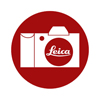 Sardegna - Sud Est
Sardegna - Sud Estcris7 - lug 24 2017 19:27
-
 Avignone - Il festival off
Avignone - Il festival offMassimo Vignoli - lug 18 2017 21:59
-
 [editoriale] Garanzia cinqueminuti...
[editoriale] Garanzia cinqueminuti...Max Aquila - lug 12 2017 12:21
-
 [motori] Monza Historic
[motori] Monza HistoricGiannantonio - lug 06 2017 13:39
-
 [libro Nikonland centenario] だいすきニコン (daisuki Nikon)
[libro Nikonland centenario] だいすきニコン (daisuki Nikon)Alberto73 - lug 04 2017 21:52
-
 [manifestazioni] TRATTA 29 giugno 2017
[manifestazioni] TRATTA 29 giugno 2017tommowok - giu 30 2017 13:23
-
 [luoghi] i laghi del Trentino
[luoghi] i laghi del TrentinoAlberto73 - giu 29 2017 21:13
-
 [reportage] Tre Torri
[reportage] Tre TorriGiannantonio - giu 28 2017 15:46
-
 [Nikonland libro Centenario] come da tag
[Nikonland libro Centenario] come da tagValerio Brùstia - giu 26 2017 00:06
In evidenza
-
 Le Nikon del 2017
Le Nikon del 2017Lieve - feb 08 2017 08:36
-
 16 ottobre - 2006-2016 : dieci anni della nostr...
16 ottobre - 2006-2016 : dieci anni della nostr...Lieve - ott 16 2016 06:03
-
 La Stampa in Bianco e Nero
La Stampa in Bianco e NeroSpinoza - mag 19 2016 19:55
-
 Nikon D5 : semper fidelis (test/prova)
Nikon D5 : semper fidelis (test/prova)Lieve - ott 30 2016 17:17
-
 La nascita di Nikon (Nippon Kogaku) e la Marina...
La nascita di Nikon (Nippon Kogaku) e la Marina...Lieve - mar 04 2015 11:11
-
 Nikon D810 : la terra promessa (test/prova)
Nikon D810 : la terra promessa (test/prova)Lieve - mar 10 2015 13:50
-
 Il fascino intramontabile delle foto stampate
Il fascino intramontabile delle foto stampateLieve - mag 22 2014 09:23
-
 Calibrare e Profilare il monitor. Guida pratica
Calibrare e Profilare il monitor. Guida praticaSpinoza - mag 13 2014 12:57
Ultime News
-
 25 luglio 2017 : fine della ricreazione
25 luglio 2017 : fine della ricreazioneLieve - lug 28 2017 11:02
-
 La Nikon D850 ha un mirino ibrido ?
La Nikon D850 ha un mirino ibrido ?Lieve - lug 27 2017 05:40
-
 Importante aggiornamento firmware per la Nikon...
Importante aggiornamento firmware per la Nikon...Lieve - lug 12 2017 07:50
-
 Nuovo Nikon AF-P 70-300mm F4.5-5.6E VR (FX)
Nuovo Nikon AF-P 70-300mm F4.5-5.6E VR (FX)Lieve - lug 11 2017 07:28
-
 New Old Camera : servizio 'demo' e Meet...
New Old Camera : servizio 'demo' e Meet...Lieve - giu 12 2017 07:41
-
 Nuovo Nikon 10-20mm F4.5-5.6 VR
Nuovo Nikon 10-20mm F4.5-5.6 VRLieve - lug 07 2017 16:49
-
 Nuovo Nikon 8-15mm F3.5-4.5E Fisheye
Nuovo Nikon 8-15mm F3.5-4.5E FisheyeLieve - mag 31 2017 07:23
-
 Nuovo Nikon 28mm F1.4E
Nuovo Nikon 28mm F1.4ELieve - mag 31 2017 07:36
-
 Fotografia, messaggi, il tempo in cui viviamo.
Fotografia, messaggi, il tempo in cui viviamo.Lieve - giu 25 2017 05:35
-
 Il dado è tratto. Sarà il 2018 l'anno mirro...
Il dado è tratto. Sarà il 2018 l'anno mirro...Lieve - lug 12 2017 07:15
1970 Nikon Multiphot
set 07 2007 15:20 |
Lieve
in Storia
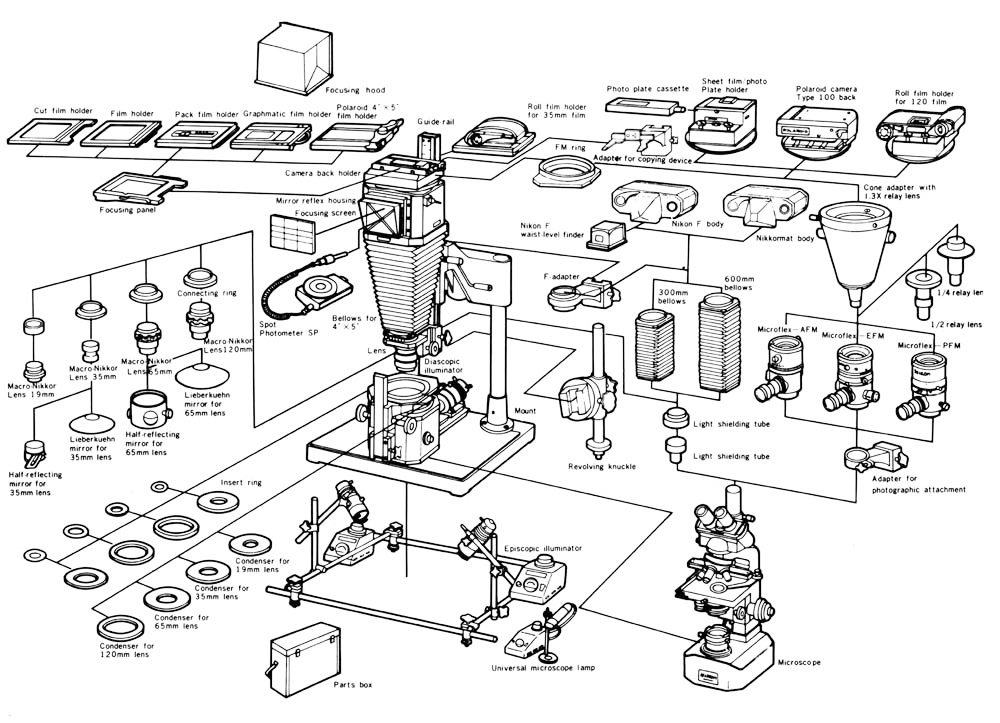
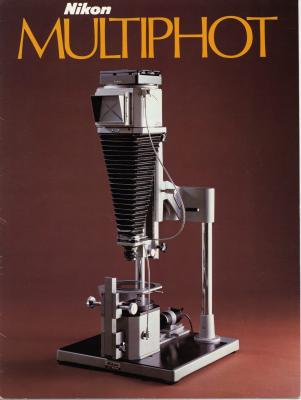
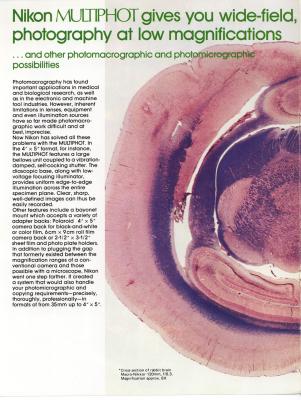
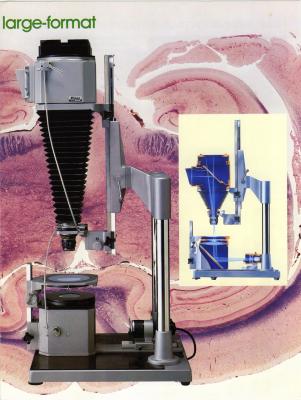
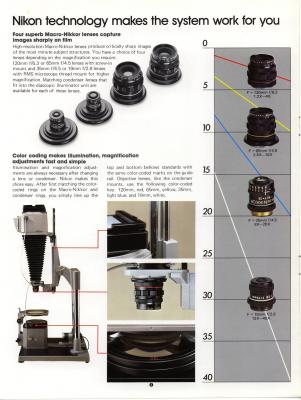
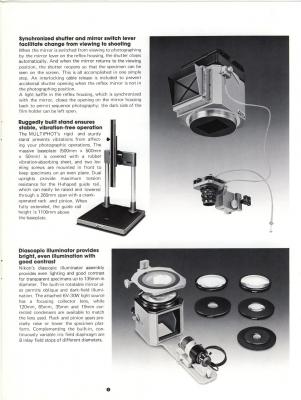
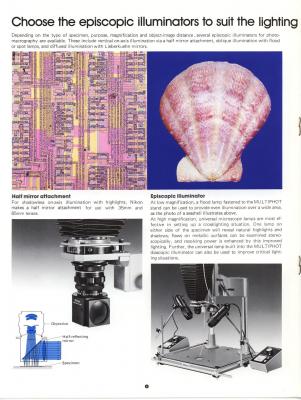
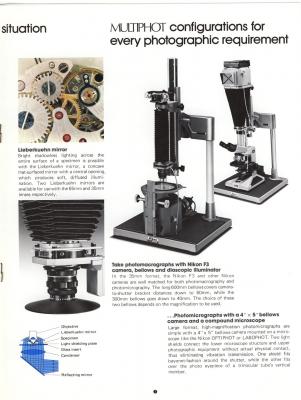
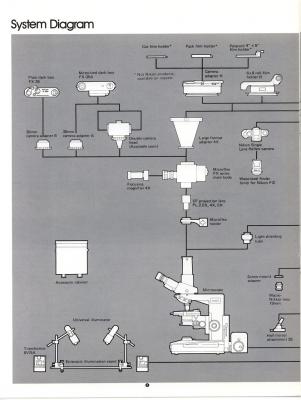
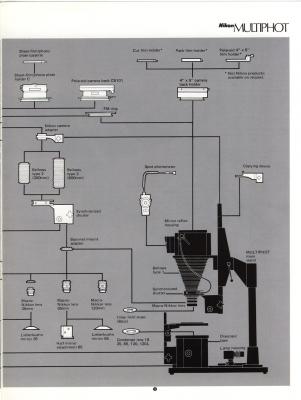
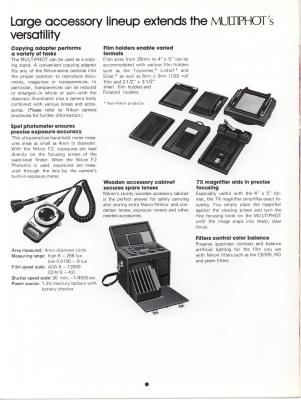
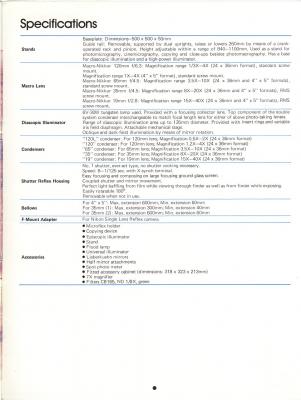
Nikon Multiphot Microscopio per macrofotografia in grande formato
Il Multiphot, costruito durante gli anni '70 e '80, fu specificatamente progettato per la fotografia a grande formato a basso ingrandimento così come per altri campi della macro fotografia e della microfotografia.
Le limitazioni inerenti la tecnologia degli obiettivi, dei dispositivi disponibili per l'illuminazione possono rendere il lavoro difficoltoso e nella migliore delle ipotesi impreciso.
Il Microphot risolveva questi problemi assicurando immagini nitide e ben definite.
In un formato 4x5 pollici standard, il Multiphot si caratterizzava con una unità a soffietto accoppiata con un otturatore automatico particolarmente smorzato.
La base diascopica con una lampada di messa a fuoco a bassa tensione consentiva inoltre una illuminazione uniforme da bordo a bordo per l'intero campione da riprodurre.
La macchina era corredata da quattro obiettivi per quattro ingrandimenti che producevano immagini particolarmente nitide anche dei più minuti particolari.
Altre caratteristiche riguardavano la disponibilità di innesti per vari dorsi : Polaroid 4x5 pollici, con film a colori o in b&n, rullini da 6x9 centimetri o lastre da 2,5x3,5 pollici.
Con il Multiphot, Nikon ha creato un dispositivo che é in grado di colmare il vuoto esistente tra la fotografia convenzionale e quella possibile con un microscopio.
Altre informazioni trovate su Microspopyu Museum riguardanti i microscopi Nikon :
Nikon's Museum of Microscopy
Nikon's First Microscope - Nikon, one of the world's largest manufacturers of microscopes and cameras, made this microscope in the early 1900s. The compound monocular microscope is fashioned from brass and has a black-enameled horseshoe base.
Halogen Lamp Illuminator (Model S-Ke) - The add-on halogen illuminator was built specifically for use with either the Nikon model S-Ke or L-Ke microscopes, both of which were manufactured during the late 1960s and early 1970s. Already equipped with a binocular head and mechanical stage, the additional illumination provided by the halogen lamphouse boosted these microscopes onto front stage of the research arena.
Interference-Phase Microscope Accessory - This device, built as an add-on in the early 1970s, was attached to Nikon microscopes to allow observation and discrimination of minute differences in thickness and refraction of non-stained transparent specimens, making it possible to estimate phase and refractive index differences.
Microflex Model PFM Photomicrography Accessory - Designed primarily for 35-millimeter photography, this unit was a reflex-type photomicrographic attachment with a built-in shutter and focus finder. Built during the 1970s, there were a variety of interchangeable parts and accessories that made the Microflex PFM a versatile and adaptable tool for taking photographs through the microscope.
Model G - Produced in the 1960s and 1970s, this inclined monocular microscope could also accept most of the accessories designed for the model S, and was equipped with a modest set of objectives having contemporary numerical apertures and mounted on a rotating turret.
Slit Lamp CS-1 Microscope - Nikon slit lamp microscopes are used by ophthalmologists to directly examine the eyes of a patient under the magnification of a binocular microscope by creating a stereoscopic, erect image. Known also as biomicroscopes, slit lamp microscopes, like the Nikon CS-1 illustrated below, are based on the 1902 design of Swedish ophthalmologist and Nobel Laureate, Allvar Gullstrand.
Model GH - Identical to the model G, the GH-series microscope was equipped with a mechanical stage to ease the burden of linear specimen examination. Specimen translation was accomplished with a pair of knurled chrome-plated knobs that moved the microscope slide in the X- and Y-directions.
Model M Inverted Microscope - Built in the early 1970s, this black-enameled inverted microscope was designed for both biological (diascopic) and metallurgical (episcopic) use with brightfield and phase contrast illumination.
Model S - Interchangeable parts made the Model S microscope a versatile tool for studies in biology, medicine, and metallurgy during the 1960s and 1970s. Depending on the user's needs, the microscope could be equipped with various combinations of eyepieces, eyepiece tubes, objectives, condensers, and stages.
Model S-Ke - The S-Ke was the first Nikon microscope equipped with a K?hler illuminator built into the microscope base, enabling convenient and perfect photomicrography when a camera was mounted and used with one of Nikon's Microflex adapters. A reflecting mirror was provided as an accessory and could replace the illumination field lens to provide light from a source outside the microscope.
Model S-Po - The model S-Po was a specialized version of the model S microscope, manufactured in the early 1970s, that came equipped with a polarizer unit, analyzer unit, "polarized" eyepiece, and a graduated circular rotatable stage. Depending on the user's needs, the microscope could be equipped with various combinations of eyepieces, eyepiece tubes, objectives, condensers, and stages.
Model S Epi-Illuminator - The epi-illuminator converted the Model S microscope from a tool for studying translucent biological specimens into a tool for studying the surface of opaque specimens such as metals.
Stereoscopic Microscope Model SM-5 - The SM-5 stereoscopic microscope, built during the 1960s, comprises a binocular microscope head, zoom body, and a vertical column with a metal stage. Although most objects to be observed were placed on the stage, the microscope could also be detached from the stage and used for observing any subject placed beneath the objective.
Model SMZ-800 - The SMZ-800 model stereoscopic microscope, available since the late 1990s, is equipped with several ergonomic features that can reduce fatigue when spending hours observing through the microscope. A number of auxiliary stages, eyepiece tubes, and camera systems are available for this microscope system.
Diaphot Inverted Tissue Culture Microscope - This workhorse tissue culture microscope features advanced optical design for the shortest, most efficient light path. Accessories include an incubator, a reflected light fluorescence system, and a Nomarski differential interference contrast optical system. Two integral camera ports support photomicrography with a 35-millimeter camera and cinemicrography with digital or analog video cameras. Objectives were the last 160-millimeter tube length variety offered by Nikon before the company advanced to infinity-corrected optics.
Labophot Entry-Level Research Microscope - The Labophot was a sturdy, versatile microscope, produced in the 1980s. It offered research-level performance and a modular system that made it highly adaptable for clinical, biological, industrial, and educational laboratories. The Labophot utilized the Nikon CF optical system, which yielded high-quality images previously attainable only in costly research instruments.
Multiphot Large-Format Photomacrography Microscope - The Multiphot, built during the 1970s and 1980s, was specifically designed for wide-field, large-format photography at low magnifications as well as for other photomacrographic and photomicrographic possibilities. In addition to filling the gap that formerly existed between the magnification ranges of a conventional camera and those possible with a microscope, Nikon created a system that would also handle photomicrographic and copying requirements in formats of 35-millimeter up to 4 x 5 inches.
XD-20 Large Substrate Microscope - Manufactured in the early 1990s, the XD-20 microscope for large substrate inspection was tailored to fit the needs of thin film transistor color liquid crystal display (LCD) manufacturers. Other uses include semiconductor wafer inspection, circuit board analysis, and examination of a wide spectrum of electronic components.
SMZ-U Stereoscopic Zoom Microscope - The SMZ-U was Nikon's top of the line stereoscopic zoom microscope when first introduced. Available since the early 1990s, the SMZ-U has an optical system with a 10:1 zoom, which provides uniformly flat images with virtually no distortion or aberrations. Ergonomic features make this microscope easy and comfortable to use for long periods of observation.
Eclipse Series - Introduced in 1997, the Eclipse series of microscopes represents Nikon's latest efforts to produce state-of-the-art optical microscopes to meet the demanding needs of today's researchers in both the biological and materials science arenas. Based on the revolutionary CFI60 optical system, the Eclipse microscope series provide aberration-free optics with longer working distances and higher numerical apertures than previous models.
Eclipse E200 - Among the many features of this entry-level student microscope are a refocusing stage that eliminates the need to refocus the image manually when dropping the stage to exchange specimens or add oil to a slide. The microscope is also coated with an anti-mold reagent at strategic locations to help combat mold growth in hot and humid work environments.
Eclipse E600 - Nikon's Eclipse E600 research microscope is equipped with the revolutionary CFI60 infinity optical system, providing bright, sharp, crisp and clear images in all applications. Available since the mid-1990s, the mid-tier microscope incorporates completely new specifications adopted for the CFI60 series objectives, including a 60-millimeter parfocal distance, a 25-millimeter thread size, and a standard 22-millimeter field of view. An ergonomic design allows for longer periods of comfortable observation.
Eclipse E600POL - The Eclipse E600POL, based on Nikon's popular Eclipse E600 microscope, features a 12 volt-100 watt internal tungsten halogen illumination system that tunnels through the base to provide bright and stable diascopic K?hler illumination. General construction parameters for the microscope center around a universal (modular) frame designed to accept attachments for advanced analytical and quantitative polarized light microscopy applications.
Ringraziamo Roby_C per aver fornito il depliant originale del Microphot
Un obiettivo per il Nikon Multiphot :
Il Sistema al completo :
0 user(s) are online (in the past 15 minutes)
0 utenti, 0 ospiti, 0 utenti anonimi


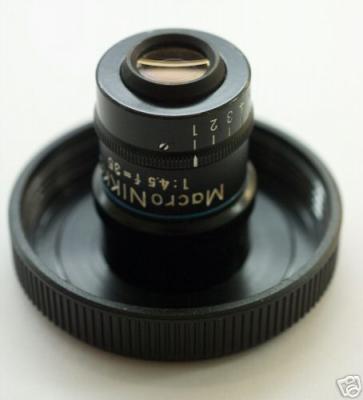
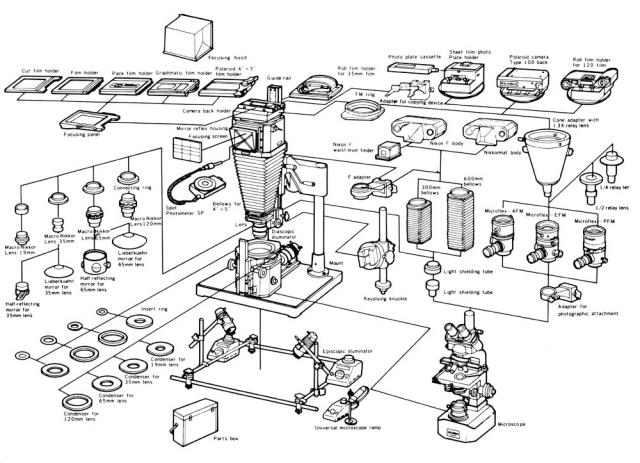











2 Comments
a_
hai..hai.. stai invecchiando...